No products in the cart.
Chicken
Top 10 Safest Alternatives To Heat Lamp For Chickens
Although heat lamps are popular at feed stores as the cheapest way to keep your poultry warm in winter, they pose some risks to chickens like fire or permanent damage to their eyes.
Thus, you should choose a safer alternative to heat lamps for chickens to maintain a comfortable and warm environment without badly affecting their health and natural habitats.
*This post may have affiliate links, which means I may receive commissions if you choose to purchase through links I provide (at no extra cost to you). As an Amazon Associate I earn from qualifying purchases. Please read my disclaimer for additional details.
Why Use Chicken Heat Lamp Alternatives?
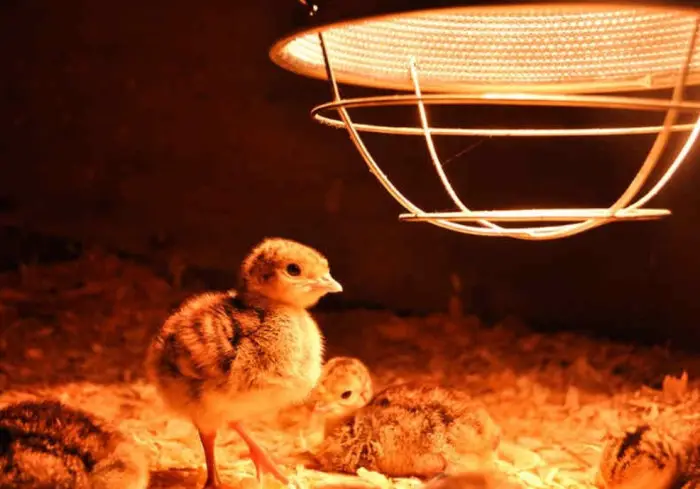
A brooder heat lamp can be cheap at first, but it is not economical in the long run with extra electricity costs and bulb replacement costs.
Besides, there are also some risks surrounding this supplement heat.
First, there are a lot of combustible materials in the brooder like feathers, dust, dry wood shaving/straw. When a heat source like a chicken heat lamp comes into contact with these materials for an extended period, it can cause fire hazards and kill all chickens in the coop. An overheating electric cord extension can lead to this tragedy if you don’t notice soon.
Second, all heat lamps on the market are not designed to be secured stably. Even some tiny water drops accidentally can explode the bulb and hurt your chicken inside.
Third, continuous exposure to an artificial light source like heat lamps is proven to cause permanent eye damage to chickens. The red heat lamp is advertised to lower the between the day and night rhythms, but in fact, it only makes this situation worse. Besides, this supplemental heat source can trigger bullying or feather pecking in poultry.
Read our related article, How Cold Can Baby Chicks Handle? Chicks need high temperatures to survive. Here are the temperatures that are too cold.
10 Safe Alternatives To Heat Lamp For Chickens
1. Brooder heating plate
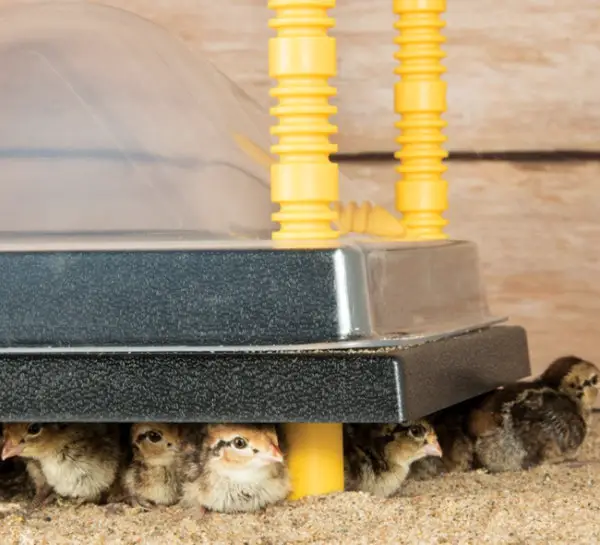
A brooder heating plate is an excellent alternative to a heat lamp for chickens in winter. It is a flat, rectangular device that looks like a plate. You can lay it on the ground and let chicks sleep on top, or hang it on the wall so that your brooded chicks can hide underneath them.
This plate is easy to use and follows the natural heating principle of mother hens. When using this artificial heat source, chicks can quickly be familiar with the day/night cycle. They can also grow feathers faster and wean off this heat source faster than those who rely on the heat bulbs. And although this plate has a higher upfront cost than a heat lamp, it can save your electricity cost, in the long run, better than a 250-Watt bulb.
Despite its convenience, this brooder heating plate also has some disadvantages.
- First, it is hard to apply for chicks below 50oF. Hence, you should check your local temperatures before getting this product.
- Second, it is more suitable for small coops of 5-10 chicks but hard to be used on large broods. Some items are advertised to be used for 20 chicks, but these chicks can outgrow that plate soon.
RentACoop Chick Brooder is an excellent heating plate for chicken owners. This plate can serve up to 20 chicks at first and even when growing up. You can customize the plate’s size to best accommodate your chick’s growth rate with adjustable height settings from 1 to 7 inches and the temperature between 105 and 110oF, just like a mother hen.
Read More: How Do Chickens Sleep at Night? Learn how chickens sleep, how they sleep standing, and the sleep stages they experience!
2. Heated pads
An electrically heated pad is also a simple yet efficient accessory to keep your flock warm when sitting or lying on it on sub-freezing days. This product comes with pre-drilled holes, allowing you to attach it to a wall horizontally or vertically.
Another strong plus of this pad is that it uses a small amount of electricity (around 25-30 Watts) for heating. Thus, it is safer than 250-Watt heat lamps.
When your chicks are one month old, you can find a heated pad like this 9×12-inch K&H Thermo-Chicken Heated Pad to keep them warm until they wean off supplemental heating.
This pad is made of sturdy ABS plastic with a steel-coating electric cord and round edges. It also has a low wattage of only 25 Watts. Thus, it is safe and economical to keep your little birds warm inside or outside their housing. For adult birds, you can use a bigger one of 12.5×18.5”.
3. Infrared Heater for Chicks
This supplemental heater has the same functionality as the two above items, but you can install it in two ways: hang it on a wall or hang it overhead your chicken’s coop.
It also uses less electricity than the heat lamp, which is energy-efficient and safe for your little feathered friends.
If your chicks lack their mother hen for any reason, you can use the Sweeter Heater Infrared Heater to keep them warm and comfortable inside. This 11x11x2 heater comes with a mount, chain, and hooks for quick assembly.
The heat from this heater is evenly distributed in their house, ensuring that all chicks are warm and comfortable before they have enough feathers to maintain their body temperature.
4. Ceramic Heat Emitter
A ceramic heat emitter is not as fragile as a brooder heat lamp. It is stronger, fireproof, and doesn’t produce light to disturb your chicks’ sleeping cycle at night. In other words, you can keep this artificial heater on all the time without worrying about accidents or eye damages to your animals.
If you decide to go with this chicken heat lamp alternative, BOEESPAT Ceramic Heat Emitter is an ideal choice for you. This item has a high thermal efficiency of up to 99%.
The ceramic shell can concentrate the heat on its ceramic disc and evenly distribute the heat broader than a heated pad or a heating plate. It also has remarkable durability of 15,000 hours of continuous working.
Read our related article, How to Keep Chickens Warm in Winter WITHOUT Electricity. If you don’t have electricity running to your coop, these tips can help!
5. Feather Dusters
What can I use instead of a heat lamp that won’t add up to my monthly electricity bill?
If you have a small number of chicks and all of them are a few days old, you can use a simple tool like a feather duster to mimic their mother hen. Chicks will sit underneath the duster and create insulation to keep all of them warm without wasting electricity.
A pitfall of this heating method is that you should ensure that your chicks are old enough and have some feathers to start regulating their body temperature.
Ostrich Feather Duster is an affordable yet safe tool to use on small farms. Apart from insulating your chicks, you can use this duster to clean the dust in your house.
6. Use thick beds
Add a lot of dry shavings to make comfortable and warm bedding for your little chicks.
What is the best bedding for chickens?
Pine is the best option for bedding, while cedar is not advisable due to its high toxicity.
Besides the bedding type, you should also check the finest level of shavings. Fine shavings promote the growth of moisture and mold. Thus, you should choose shavings with large flakes like Small Pet Select Pine Shavings. This item is 99% dust-free and won’t disturb your chicks. It is also biodegradable or compostable, a strong plus for sustainable farming.
7. Hot water bottles
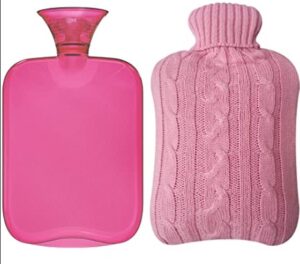
What can I use as a heat lamp for chickens when there is no available electricity or in a sudden power outage?
You can use hot water bottles to keep your chicks warm. Remember to cover it with a towel or something similar to keep it insulated and prevent your kids from accessing the hot bottle.
Since your chicks need a high ambient temperature of 95oF in their first 2-3 weeks, this solution is inefficient to use in an unheated building.
8. Mother hens
You can use mother hens on your farm as a natural and safe heat source for chicks from one day old. These brooding hens will not only keep your chicks warm but also protect, train, and raise them – those are the things that an artificial heater can’t do.
However, this brooding option is hard for you when raising your first chicks, as there are no hens available on your farm.
Another problem when choosing mother hens to insulate your chicks is the temperament of the mother hens themselves. Some hens will reject the given chicks, while others only accept brood and hatch eggs but refuse to raise chicks.
The temperament of the rest of the flock also matters. To avoid aggressive chickens from attacking new chicks, you should keep the babies and their mother hen apart from them. But if the coop isn’t large enough, chicken grouping might be impossible.
Read More: Why Do Hens Lay Unfertilized Eggs? Here are some reasons why hens lay unfertilized eggs and how to tell them apart from fertilized eggs!
9. Wool hen
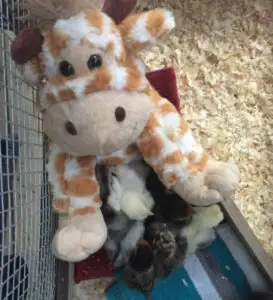
A wool hen is a thick insulated box stuffed with strips of wool, fleece, or high-insulating fabrics. When chicks get into this box, they will be kept warm using their body heat instead of electricity or a real mother hen.
However, there is no confirmation on the lowest temperature that this box can handle while being used outdoors.
10. Keep chickens in a large group
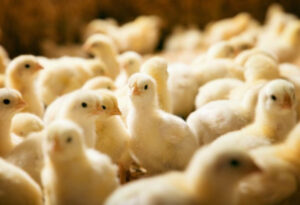
Just like penguins, chicks love snuggling themselves in the crowd. If it is your first time raising chicks, you should keep a minimum headcount of 25 chicks in the brooder so that they can cluster together and take turns to be in the middle of the group.
Add More Heat In The Winter
If you live in an area that experiences cold temperatures a few months a year, you should choose a heating product to keep all your chickens, including hens, roosters, and chicks, warm and comfortable. Below are the two most popular products you can consider getting for your chicken farm.
Heated perch
A heated perch warms the entire chicken’s body by warming its toes. Since it utilizes the bird’s circulation system, it keeps your chickens warm gently without hurting or overheating them.
Heated waterer for chickens
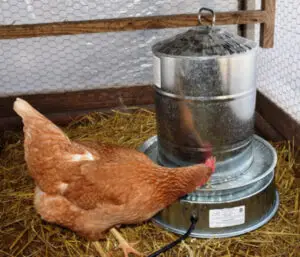
A heated waterer is a water container with a thermo-statistically controlled, aiming to encourage your chickens and birds to stay well-hydrated in the cold and dry weather. It keeps them warm by providing them with clean and warm water in a closed container.
Before getting one, ensure that all chickens can easily access the waterer. The waterer, either hanging on the coop or placed on the ground, should have a design that prevents dust, feathers, and small particles from getting inside.
You should also check if there is a removable top that allows you to refill water or clean the waterer.
Read our related article, What Temp is too Hot for Chickens? Learn what temperatures are too hot for your chickens to handle.
FAQs
1. Can chickens survive without a heat lamp?
Unlike humans, chickens, goats, and cows have thick layers of feathers to withstand harsh weather conditions. So, most of the time, they don’t need extra heat even when the outer temperature is below zero degrees. An adequately designed coop can also keep your animals thriving well for most winter temperatures without using heating products.
However, if you are raising chicks on your farm or raising breeds that cannot be well-suited to cold weather (like Egyptian Fayoumi, Silkies, frizzles), you can choose a safer alternative heat lamp for chickens until the chicks are mature. Mother hen is also a natural heat source.
2. Why do chicks need to stay warm?
Unlike adult chicks who can maintain a consistent body temperature through metabolism, young chicks lack feathers to keep them warm. Thus, they have to rely on their mother hen for protection against cold winter days.
3. What temperature should I keep for baby chicks?
An ambient temperature of approximately 90oF is ideal for keeping baby chicks comfortable in their first 2-3 weeks.
4. How cold is too cold for chicks?
A temperature of 75oF or below is too cold for chicks. When chicks are too cold, they can be unwell or even die.
5. When do baby chicks outgrow the heater?
Most chicks can outgrow the heater when they are 6 weeks old. By this age, they can learn to regulate their body temperature.
The exact heater wean-off timing also depends on the outer temperature. If the weather is warmer, they can go outside when they are 4 weeks old. However, if the temperature is below 40oF, you still need to keep the brooder heater longer.
Final Words
Heat lamps might be cheap at first, but they can cost you more electricity and pose some serious risks to your chickens. If you know how to utilize an appropriate alternative to heat lamp for chickens among these suggestions of mine, you can keep your birds warm, comfortable, and safe in this harsh winter with minimal costs and risks.







